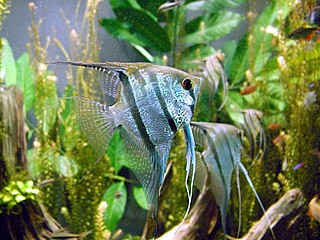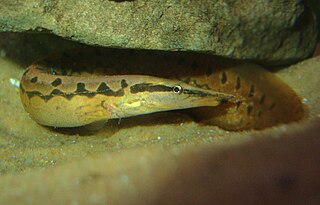
Crayfish are freshwater crustaceans belonging to the infraorder Astacidea, which also contains lobsters. Taxonomically, they are members of the superfamilies Astacoidea and Parastacoidea. They breathe through feather-like gills. Some species are found in brooks and streams, where fresh water is running, while others thrive in swamps, ditches, and paddy fields. Most crayfish cannot tolerate polluted water, although some species, such as Procambarus clarkii, are hardier. Crayfish feed on animals and plants, either living or decomposing, and detritus.

The red-eared slider or red-eared terrapin is a subspecies of the pond slider, a semiaquatic turtle belonging to the family Emydidae. It is the most popular pet turtle in the United States, is also popular as a pet across the rest of the world, and is the most invasive turtle. It is the most commonly traded turtle in the world.

Angling is a fishing technique that uses a fish hook attached to a fishing line to tether individual fish in the mouth. The fishing line is usually manipulated via a fishing rod, although rodless techniques such as handlining also exist. Modern angling rods are usually fitted with a fishing reel that functions as a cranking device for storing, retrieving and releasing out the line, although Tenkara fishing and traditional cane pole fishing are two rod-angling methods that do not use any reel. The fish hook itself can be additionally weighted with a denser tackle called a sinker, and is typically dressed with an appetizing bait to attract and entice the fish into swallowing the hook, but sometimes an inedible fake/imitation bait with multiple attached hooks is used instead of a single hook with edible bait. Some type of bite indicator, such as a float, a bell or a quiver tip, is often used to relay underwater status of the hook to the surface and alert the angler of a fish's presence.

Hermit crabs are anomuran decapod crustaceans of the superfamily Paguroidea that have adapted to occupy empty scavenged mollusc shells to protect their fragile exoskeletons. There are over 800 species of hermit crab, most of which possess an asymmetric abdomen concealed by a snug-fitting shell. Hermit crabs' soft (non-calcified) abdominal exoskeleton means they must occupy shelter produced by other organisms or risk being defenseless.

The Denison barb, Denison's barb, Miss Kerala, red-line torpedo barb, or roseline shark is an endangered species of cyprinid fish endemic to the fast-flowing hill streams and rivers of the Western Ghats in India. It is commonly seen in the aquarium trade; pet collection caused it to become endangered and is its single major threat.

The giant danio is a tropical fish belonging to the minnow family Cyprinidae. Originating in Sri Lanka, Nepal, and the west coast of India, this species grows to a maximum length of 4–6 inches (10–15 cm), making it one of the largest of the danionins. It is characterized by a blue and yellow, torpedo-shaped body with gray and clear fins.

Pterophyllum is a small genus of freshwater fish from the family Cichlidae known to most aquarists as angelfish. All Pterophyllum species originate from the Amazon Basin, Orinoco Basin and various rivers in the Guiana Shield in tropical South America. The three species of Pterophyllum are unusually shaped for cichlids being greatly laterally compressed, with round bodies and elongated triangular dorsal and anal fins. This body shape allows them to hide among roots and plants, often on a vertical surface. Naturally occurring angelfish are frequently striped transversely, colouration which provides additional camouflage. Angelfish are ambush predators and prey on small fish and macroinvertebrates. All Pterophyllum species form monogamous pairs. Eggs are generally laid on a submerged log or a flattened leaf. As is the case for other cichlids, brood care is highly developed.

The Dungeness crab makes up one of the most important seafood industries along the west coast of North America. Its typical range extends from Alaska's Aleutian Islands to Point Conception, near Santa Barbara, California. Dungeness typically grow 6–7 in (150–180 mm) at their widest point and inhabit eelgrass beds and sandy bottoms. Its common name comes from the Dungeness Spit in the Strait of Juan de Fuca, Washington state, United States, which shelters a shallow bay inhabited by the crabs.

The Ecuadorian hermit crab also known as the Pacific hermit crab is a species of land hermit crab. It is one of the two land hermit crabs commonly sold in North America as pets, the other being the Caribbean hermit crab.

The Chinese mitten crab, also known as the Shanghai hairy crab, is a medium-sized burrowing crab that is named for its furry claws, which resemble mittens. It is native to rivers, estuaries and other coastal habitats of East Asia from Korea in the north to Fujian, China in the south. It has also been introduced to Europe and North America, where it is considered an invasive species. The species features on the list of invasive alien species of Union concern. This means that the import of the species and trade in the species is forbidden in the whole of the European Union.

Siebenrockiella leytensis is a species of freshwater turtle endemic to the Philippines. It is classified as critically endangered. It is known as the Philippine forest turtle, the Philippine pond turtle, the Palawan turtle, or the Leyte pond turtle. Despite the latter common name, it does not occur in the island of Leyte but is instead native to the Palawan island group. It is locally known as bakoko in Cuyonon.

The red-tailed black shark, also known as the redtail shark, red tailed shark, and redtail sharkminnow, is a species of tropical freshwater fish in the carp family, Cyprinidae. It’s named after its shark like appearance and movement, as well as its distinctive red tail. Despite its name, it is more closely related to carp. It is endemic to streams and rivers in Thailand and is currently critically endangered. However, it is common in aquaria, where it is prized for its deep black body, and vivid red orange tail. These are moderately sized tropical aquarium fish who are active benthic swimmers. They are omnivorous but are willing to scavenge if the opportunity arises. They are known for their activity as well as their temperament towards other fish. The red-tailed black sharks seen in the aquarium trade today are all captive bred.

Fishkeeping is a popular hobby, practiced by aquarists, concerned with keeping fish in a home aquarium or garden pond. It is a practice that encompasses the art of maintaining one's own aquatic ecosystem, featuring a lot of variety with various water systems, all of which have their own unique features and requirements. Fishkeeping primarily serves as a token of appreciation and fascination for marine life and the environment that surrounds such, along with other purposes such as the piscicultural fishkeeping industry, serving as a branch of agriculture, being one of the most widespread methods of cultivating fish for commercial profit.

The common kusimanse, also known as the long-nosed kusimanse or simply kusimanse, is a small, diurnal member of the Mungotinae.

Halocaridina rubra, the Hawaiian red shrimp or volcano shrimp is a small red shrimp of the family Atyidae, with the common Hawaiian name ʻōpaeʻula.

The zig-zag eel, also known as the Baim, tire-track, tire-track spiny-eel, freshwater spiny eel, or marbled spiny eel, is a species of freshwater ray-finned fish in the family Mastacembelidae. It is native to the riverine systems of the Indian Subcontinent, Sri Lanka, South China, Malaysia, Thailand, Vietnam, Cambodia, Indonesia, and other parts of South and Southeast Asia. The species was initially described as Macrognathus armature. Other common names for this popular captive species include the leopard spiny eel and white-spotted spiny eel.

The goldfish is a freshwater fish in the family Cyprinidae of order Cypriniformes. It is commonly kept as a pet in indoor aquariums, and is one of the most popular aquarium fish. Goldfish released into the wild have become an invasive pest in parts of North America and Australia.

Gymnothorax polyuranodon, commonly known as the freshwater moray, is a species of moray eel that is native to the Indo-Pacific region, including Sri Lanka, the Philippines, Indonesia, Papua New Guinea, the northern coastline of Australia, and various islands in the western Pacific. Other common names include the many-toothed moray, spotted freshwater moray, blackspotted moray, freshwater leopard moray, and freshwater tiger moray.

An exotic pet is a pet which is relatively rare or unusual to keep, or is generally thought of as a wild species rather than as a domesticated pet. The definition varies by culture, location, and over time—as animals become firmly enough established in the world of animal fancy, they may no longer be considered exotic.

Around 1,300 species of freshwater crabs are distributed throughout the tropics and subtropics, divided among eight families. They show direct development and maternal care of a small number of offspring, in contrast to marine crabs, which release thousands of planktonic larvae. This limits the dispersal abilities of freshwater crabs, so they tend to be endemic to small areas. As a result, a large proportion are threatened with extinction.




















